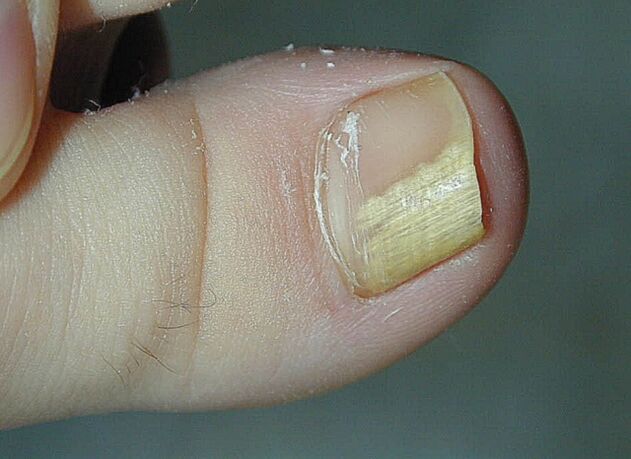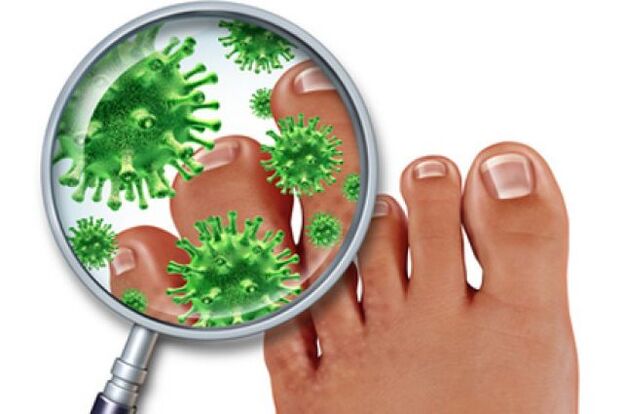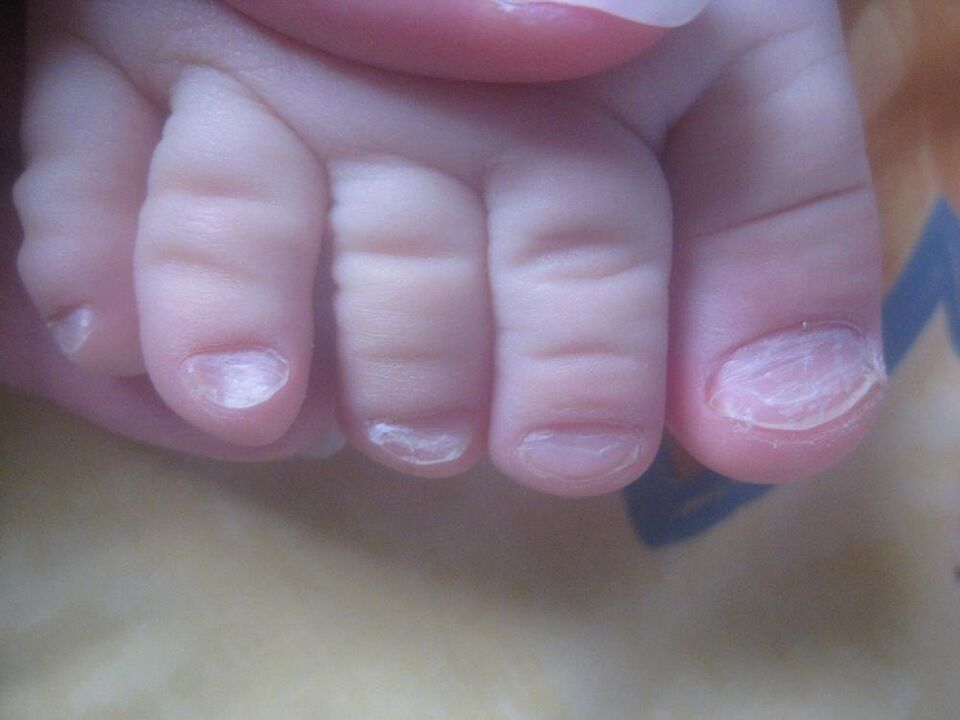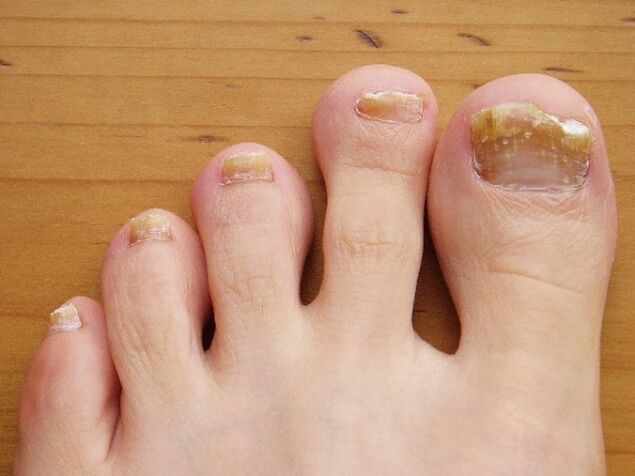Nail fungus or mycosis of the nails and tissues of the hands and feet is a common infectious disease. It is caused by yeast that damages the nail plate and causes skin inflammation. In medicine, these diseases are called onychomycosis or paronychia. The standard misconception is the assertion that only people who don't keep their hands and feet clean can get fungus. Most of the time, nail fungus affects those who have to wear shoes for extended periods of time due to occupation or other conditions.
symptom
The classification of the disease depends on the type of infection and the location of its spread.
- Normotrophic onychomycosis manifests as minor changes in the structure of the nail plate, with yellowish spots and streaks along the nail. It is the least noticeable and usually does not cause any discomfort. The main concern is the appearance of the nails, which in the initial stages people try to hide with the help of cosmetics.
- Hypertrophy of onychomycosis results in increased volume of the nail cuticle. With this disorder, a person may experience pain when pressing on their fingers. This causes inconvenience when walking with shoes on.
- Superficial white fungus is characterized by rough and unpleasant white spots on the surface of the nail plate.

Mycologists who specialize in fungal diseases can determine the cause of the disease and prescribe the correct treatment.
type of fungus
Symptoms of fungal infections are similar, but doctors choose treatment based on the type of fungus that causes the disease.
- Dermatophytes are the most common fungus that cause invasion of the nail plate and surrounding tissue. The skin of the thumb, little finger, and between the fingers is usually chosen. Early diagnosis is easy to cure
- Candida begins to work in the skin between the fingers and move to the nails.
- Fusarium and Alternaria are rare, mostly in immunocompromised people
Reason for appearing
The main cause of infection is the violation of hygiene standards. But even a person who carefully monitors the cleanliness of hands, feet and objects can become infected in public areas.
- Contact with the fungus carrier and his stuff. This could be going to the bath or sauna, using individual foreign accessories or poorly processed manicure items.
- Excessive foot sweating creates a favorable environment for the fungus to spread.
- The use of tight-fitting and poorly ventilated shoes made of man-made materials contributes to high humidity, which contributes to the development of disease.
- A weakened immune system cannot fight infection.
- Treatment with antibiotics can lead to a weakened immune system and the breakdown of the body's own microflora.
- Long-term use of antibacterial agents that destroy beneficial and pathogenic bacteria
- Vascular disease of the extremities reduces resistance and allows the fungus to destroy the integrity of the skin, which can lead to the development of the disease.
- Diabetic manifestations in the dermatological form are a favorable environment for the development of fungal colonies.
- Cuts on the skin and cracks in the nails help the fungus settle down and get to work.
- A visit to a nail salon can lead to fungal infections if the hygiene standards for processing tools are not followed.

in children
In childhood, fungal infections are less common. This is due to the properties of the organism. As you know, children's legs do not sweat too much. However, going to swimming pools and gyms can lead to infections in children. The weakened immunity of colds also contributes to this. In old age and adolescence, when there are rapid hormonal changes in children, there is also a risk of fungal infections. To prevent infection, it is necessary to monitor the cleanliness of shoes and wash them with antiseptics in time.

One of the causes of fungal infections in children may be a lack of vitamins in the body. It is advisable to fill the gaps with the help of proper nutrition and complex vitamin therapy. A doctor's consultation will help you choose a quality vitamin supplement ingredient for your child.
development process
The development of fungal infections requires favorable conditions. Sweat and wet shoes in a neutral or slightly acidic environment create comfort for fungal growth.
An unpleasant appearance of the nails, itching and pain around the nails indicate early stages of infection. If you don't treat it, after a while, the fungus can completely destroy the nail plate and reach the soft tissues of the fingers and feet. Late in the development of the disease, there may be a qualitative change in the form of blisters filled with cloudy fluid with a strong, unpleasant odor.
complication
Diseases common to the outer surface of the nail plate may not be inconvenient. In some cases, this can continue for years. Carriers of the fungus do not suffer themselves, but are able to transmit the infection to others.
The consequences of fungal infections primarily affect the nails and the tissues around them, but in the future they may have negative effects on general health.
The growth of fungal colonies causes pain in the legs and makes it difficult to put on shoes. The nails can change shape and grow into the finger tissue, causing excruciating pain when walking.

The deterioration of the immune system caused by the toxins released by the fungus during its life leads to frequent colds and inflammatory processes in the body.
Allergic reactions caused by the work products of fungi can lead to many side effects of the respiratory system and diseases of the liver and kidneys.
Infections that have settled in the body can lead to conjunctivitis, rhinitis of various etiologies. Itching, erythema, and irritation not only affect where the fungal colonies are initially located, but also the skin on the body and head. This can also affect the condition of facial hair and skin. May be part of the cause of dandruff.
Persistent itching and discomfort caused by the disease is a fairly common reason for visits to neurologists and psychotherapists.
Advanced forms of the disease cause nail loss and deformity of bones and joints.
prevention
To avoid infection, hygiene standards must be carefully observed not only when visiting public places, but also when in private places.

This is forbidden:
- Use common hygiene products. Each family member should have their own nail clippers, towel, soap, etc.
- You can't use someone else's shoes. Infections are easily spread through shared slippers in the household.
- Wash the patient's belongings with others. It must be remembered that not all detergents and washing compounds destroy fungi. This infection is very tenacious. The patient's clothing should be treated with a special solution. This is especially true for shoes. It has to be rinsed thoroughly inside and the insole changed frequently.

























